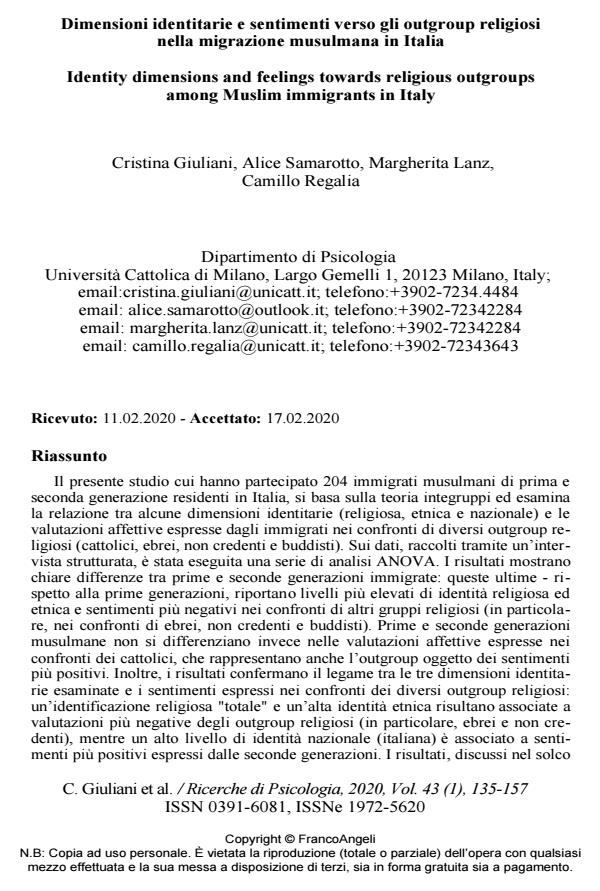Dimensioni identitarie e sentimenti verso gli outgroup religiosi nella migrazione musulmana in Italia
Titolo Rivista RICERCHE DI PSICOLOGIA
Autori/Curatori Cristina Giuliani, Alice Samarotto, Margherita Lanz, Camillo Regalia
Anno di pubblicazione 2020 Fascicolo 2020/1
Lingua Italiano Numero pagine 23 P. 135-157 Dimensione file 244 KB
DOI 10.3280/RIP2020-001007
Il DOI è il codice a barre della proprietà intellettuale: per saperne di più
clicca qui
Qui sotto puoi vedere in anteprima la prima pagina di questo articolo.
Se questo articolo ti interessa, lo puoi acquistare (e scaricare in formato pdf) seguendo le facili indicazioni per acquistare il download credit. Acquista Download Credits per scaricare questo Articolo in formato PDF

FrancoAngeli è membro della Publishers International Linking Association, Inc (PILA)associazione indipendente e non profit per facilitare (attraverso i servizi tecnologici implementati da CrossRef.org) l’accesso degli studiosi ai contenuti digitali nelle pubblicazioni professionali e scientifiche
Il presente studio cui hanno partecipato 204 immigrati musulmani di prima e seconda generazione residenti in Italia, si basa sulla teoria integruppi ed esamina la relazione tra alcune dimensioni identitarie (religiosa, etnica e nazionale) e le valutazioni affettive espresse dagli immigrati nei confronti di diversi outgroup religiosi (cattolici, ebrei, non credenti e buddisti). Sui dati, raccolti tramite un’intervista strutturata, e stata eseguita una serie di analisi ANOVA. I risultati mostrano chiare differenze tra prime e seconde generazioni immigrate: queste ultime - rispetto alla prime generazioni, riportano livelli piu elevati di identita religiosa ed etnica e sentimenti piu negativi nei confronti di altri gruppi religiosi (in particolare, nei confronti di ebrei, non credenti e buddisti). Prime e seconde generazioni musulmane non si differenziano invece nelle valutazioni affettive espresse nei confronti dei cattolici, che rappresentano anche l’outgroup oggetto dei sentimenti piu positivi. Inoltre, i risultati confermano il legame tra le tre dimensioni identitarie esaminate e i sentimenti espressi nei confronti dei diversi outgroup religiosi: un’identificazione religiosa "totale" e un’alta identita etnica risultano associate a valutazioni piu negative degli outgroup religiosi (in particolare, ebrei e non credenti), mentre un alto livello di identita nazionale (italiana) e associato a sentimenti piu positivi espressi dalle seconde generazioni. I risultati, discussi nel solco della tradizione della teoria dell’identita sociale, consentono di riflettere ? accanto alle piu note dimensioni etniche e nazionali ? sul ruolo della religione e dell’appartenenza religiosa nelle relazioni integruppi.�
Parole chiave:Migrazione, musulmani, identita, religione, outgroup.
- Migrazioni e psicologie. Introduzione al Forum Alessandro Antonietti, Antonella Marchetti, in RICERCHE DI PSICOLOGIA 1/2020 pp.13
DOI: 10.3280/RIP2020-001002
Cristina Giuliani, Alice Samarotto, Margherita Lanz, Camillo Regalia, Dimensioni identitarie e sentimenti verso gli outgroup religiosi nella migrazione musulmana in Italia in "RICERCHE DI PSICOLOGIA " 1/2020, pp 135-157, DOI: 10.3280/RIP2020-001007